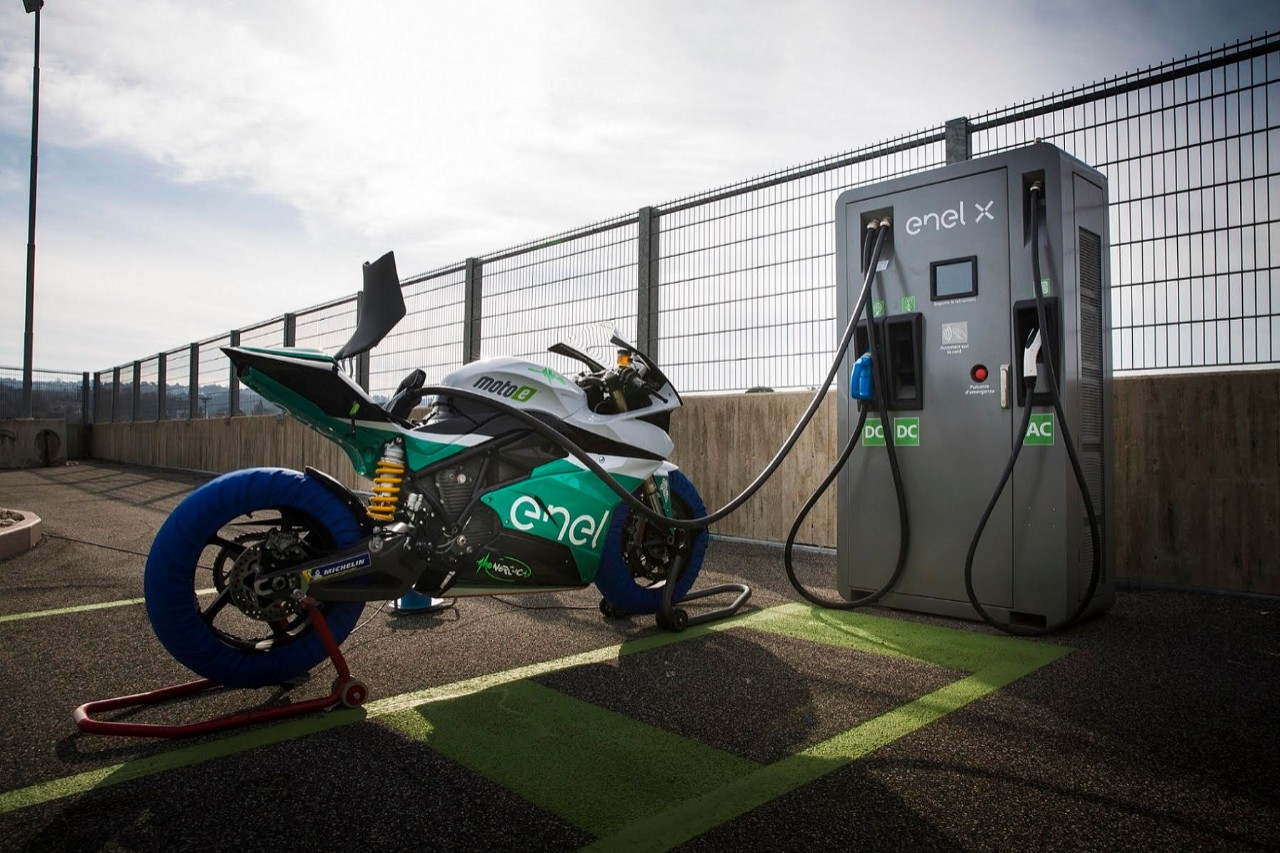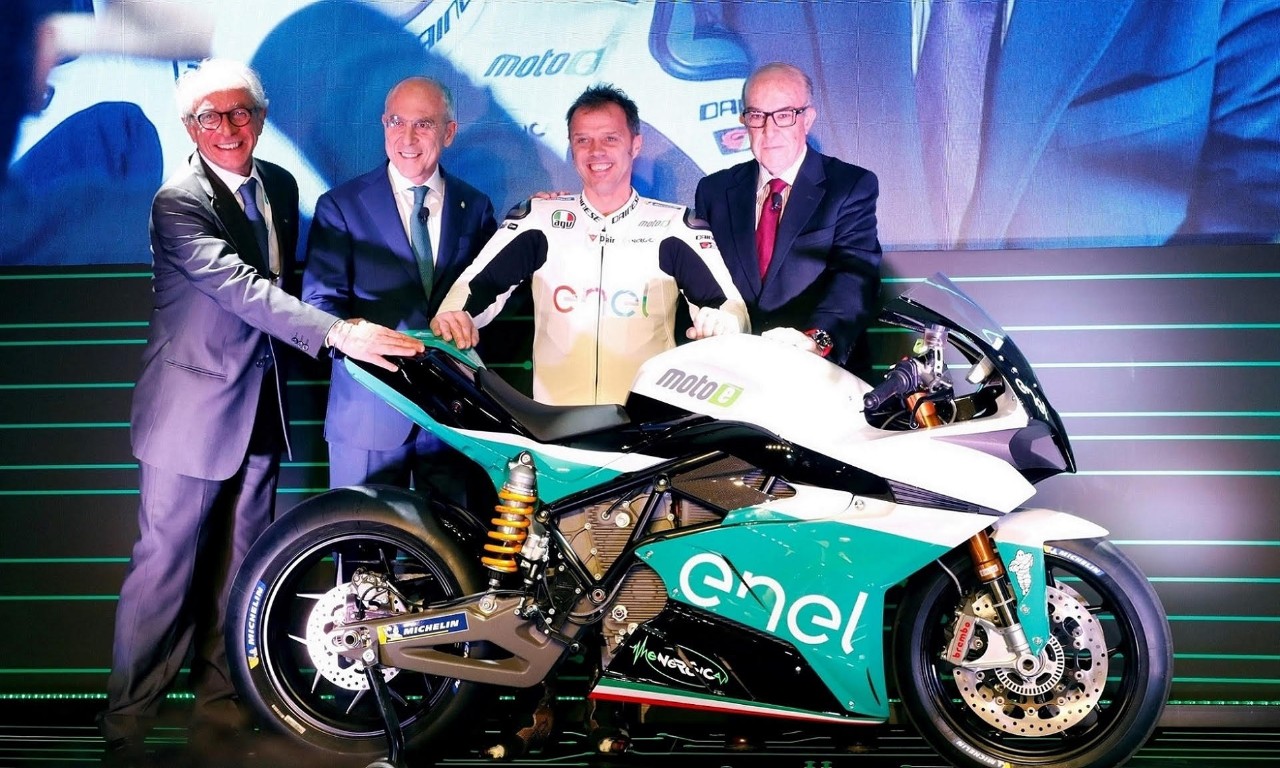Enel, Official Title Sponsor of the upcoming FIM Enel MotoE World Cup and Sustainable Power Partner of Dorna Sports’ MotoGPTM, will be providing its technology and expertise to the sport of electric motorcycle racing in 2019 when the new FIM Enel MotoE World Cup will take off from the starting blocks for the first time.
The Group’s partnership with MotoE will be on display when the first edition kicks off in 2019, contributing smart charging, advanced energy services, green energy and storage as well as technical support like the Fast Charge service to competing teams in the FIM Enel MotoE World Cup, with dedicated on-site personnel.
As MotoGP™’s Sustainable Power Partner, Enel will cooperate with Dorna to provide the FIM MotoGP™ World Championship with advanced energy solutions, including those aimed at boosting energy efficiency of the competition’s events.
Enel, through its advanced energy services division Enel X, is providing the FIM MotoE World Cup with a set of different technologies that will encompass:
1. Smart Charging technology
Enel will design and deliver smart charging devices to ensure fast charging for the Energica motorbikes. The technology will be able to charge the bikes both in the pits, when connected to the grid, but also at any other part of the circuit when in battery mode through a mobile charger with built-in storage capacity.
A specially designed battery-equipped mobile charger, which can be charged by the grid or off-grid, through distributed renewable generation, is capable of fully charging a motorcycle in less than 30 minutes. This charger will be easy to transport from the garage to the paddock or even the pitlane and will be connected to Enel’s smart e-mobility platform to optimise the charging process. The platform integrates the cutting-edge technologies of Enel’s Electro Mobility Management platform (EMM), which allows remote monitoring of charging stations, and the JuiceNet platform, developed by Enel’s US subsidiary eMotorWerks, which allows for the aggregation of distributed storage facilities.
Recently, the Group has been developing mobile charging devices suited to the world of motorsports and some of them can be used in applications such as pop-up e-vehicle parking lots or off-grid temporary EV charging to support special road events and initiatives or even road assistance to EV owners.
2. Advanced energy services
Enel will deploy its smart energy management solutions and its digital metering to grant Dorna and the MotoE teams the latest technological framework for managing complex electrical systems.
Enel will leverage on its experience in powering major events, which include the large-scale Smart Grid deployed for Expo 2015 in Milan or the portable micro-grid developed for the ABB FIA Formula E championship. Enel helped to make the New York ePrix the first zero-emission event in the championship’s history by offsetting the ePrix’s CO2 emissions through clean certificates linked to the Group’s renewable power plants combined with the deployment of a microgrid featuring bifacial solar panels and an advanced large-scale storage system.
3. Green energy
Renewable energy will be provided to charge the bikes either by generating it locally through the latest generation of portable photovoltaic systems or by using renewable energy available from local energy distribution grids. This energy from entirely renewable sources will then be used at the event to make the charging of the bikes emission free.
4. Enel Official Power Partner of the ABB FIA Formula E championship
Enel has also been the Official Power Partner of the ABB FIA Formula E (FE) championship since 2016. The Group is working with FE to implement and optimise its innovative clean energy generation, distribution and management solutions, implementing a fully digitised micro-grid that uses the company’s smart metering and energy management technology, and integrates renewable energy sources coupled with storage and electric mobility infrastructure.
On the occasion of New York's ePrix in July last year, Enel contributed its technology to make the race the first zero emission event in the championship’s history, through the offsetting of the ePrix’s CO2 emissions through clean certificates linked to Enel’s renewable power plants.
Enel has designed and developed smart meters tailor-made for FE and used for the first time at the Buenos Aires ePrix in February 2017. These meters are based on the technology behind Enel’s traditional digital meters but introduce new features to adapt them to this challenging environment, such as “plug and play” flexible design, so that FE meters are designed to be installed and removed quickly and easily in order to make them more suited to the short timeframes of a major global event.
The meters are managed via Enel’s Energy Management System (EMS), the software backbone of the micro-grid through which it is possible to monitor and manage all equipment connected to the grid. The EMS collects data from the meters and sends it to the control dashboard that Enel uses to monitor system performance.
This energy management capability has allowed Enel to introduce a dedicated app giving FE fans an interactive experience through which they can learn more about the race and discover its power aspects, including the ePrix’s real-time energy consumption.
Since the 2016 Marrakesh ePrix, Enel has installed a solar PV system coupled with an energy storage system, both of which are monitored through the EMS. Together they supply 100% renewable power to specific areas of the race site, contributing to the goal of making FE races carbon free. Last year in New York, the PV system featured bifacial solar panels coupled with the 8 kWh storage system, to which a large-scale energy storage system was added.
Enel uses floor mounted charging points for electric vehicles at each race site. The charging points are monitored through the EMM and each station has two connectors enabling simultaneous charging of two vehicles. The full-scale micro-grid deployment will be implemented using Enel’s technical competencies and solutions, including the introduction of charging stations using vehicle-to-grid (“V2G”) technology, which enables energy to be stored in the vehicles and returned to the grid if needed.




